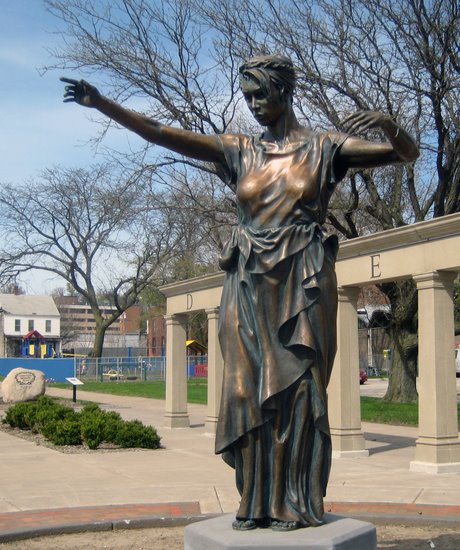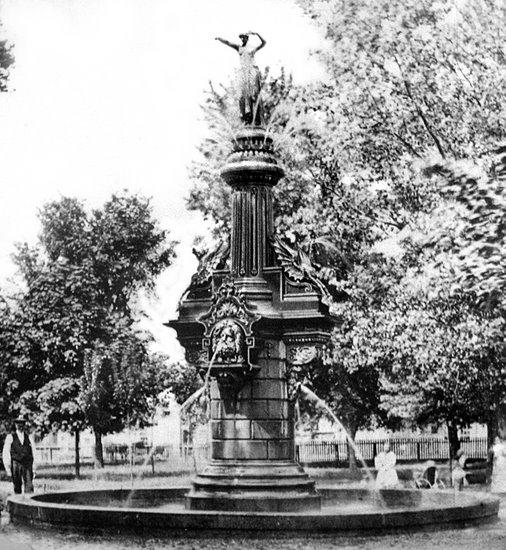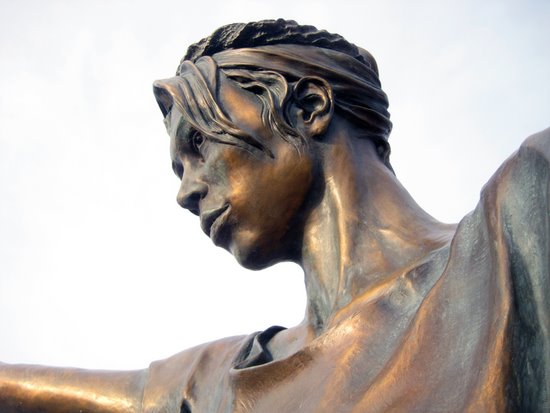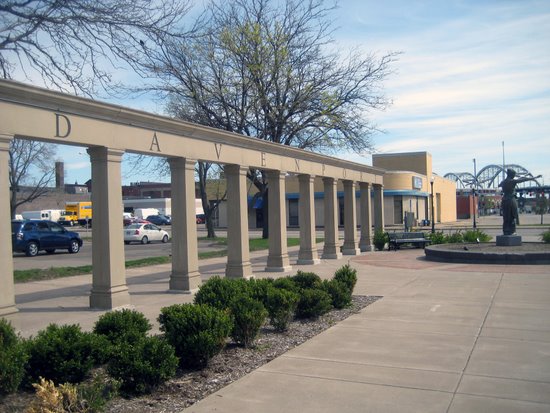Crossing the Centennial Bridge into Iowa, one is welcomed by a larger-than-life sculpture of a woman with outstretched arms. Behind her is an approximately 90-foot-long colonnade with the word "Davenport" in large capital letters across the top. This gateway is at the location of the city's first park, Washington Square, and the statue is based on a figure that once stood there.
The sculpture is the centerpiece of the first of two gateways that were completed in 2006. The other, a corporate-style sign with five-foot-tall letters, faces north on Welcome Way. According to Greg Albansoder, project manager with the City of Davenport, funding is in place for three additional gateways into the city: on West River Drive near Bettendorf, on East River Drive near Schmidt Road, and on Northwest Boulevard. Each gateway is intended to be unique and reflect the character and history of its area of the city.
It is appropriate that the first completed gateway is located downtown, where the early immigrants came into the city by riverboat and railroad. Among the first settlers were educated Germans who had fought against the entrenched aristocracy during the 1848 democratic revolutions in Europe. As Washington Square became the center of a rapidly growing German community, a 35-foot-high fountain was erected at the park's center in 1876. On top of the fountain was a statue of Germania, a symbol of strength, unity, and freedom that was closely associated with the German revolution of 1848. Facing the river, the statue's open arms welcomed all immigrants who came to Davenport.
The original statue, however, was removed and sold as scrap iron. Although the date of its removal is unclear, it likely occurred in the backlash again German Americans when the United States entered the First World War. All things German were rechristened with American and patriotic names: Sauerkraut became victory cabbage, for instance, and dachshunds became liberty pups. The German Savings Bank, the state's largest bank at the time, was renamed the American Commercial & Savings Bank. Davenport's German-language newspaper ceased publication. The anti-German hysteria reached its zenith in 1918 when Iowa Governor William L. Harding issued the Babel Proclamation, stating that only English was legal in schools, in public conversations, on trains, over the telephone, at meetings, and in religious services. In effect, German became illegal in the state of Iowa.
Eighty-eight years later, a new statue of Germania was installed at the corner of Second and Gaines streets. Titled Lady of Germania, the sculpture was created by Jeff Adams with clay and then cast in bronze in multiple pieces at his studio and foundry in Mount Morris, Illinois. It is unusual that the same artist has the skill and experience to both sculpt and cast such a large work. Adams conveys a sense of welcome through the sweeping gesture of the arms as well as strength though the figure's body. In particular, the head is beautifully sculpted. The classical style of clothing, combined with the row of columns, adds a sense of timelessness.
The gateway may be placed too close to a busy intersection and too close to the ground to be fully appreciated when driving past. If one takes the time, however, to visit this site and also the German American Heritage Center across the street, then this sculpture is more than a gateway into the city; it is also a gateway into a fascinating past.
Bruce Walters is a professor of art at Western Illinois University.
This is part of an occasional series on the history of public art in the Quad Cities. If there's a piece of public art that you'd like to learn more about, e-mail the location and a brief description to BD-Walters@wiu.edu.














